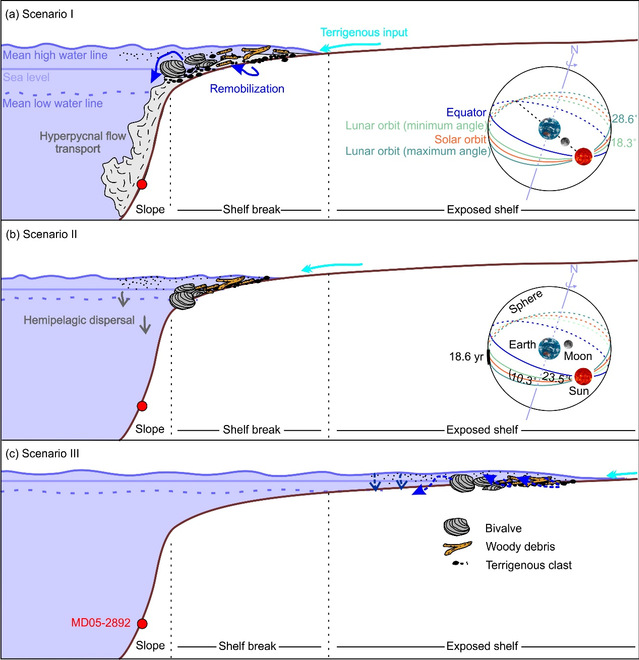Hongchao Zhao a, Zhifei Liu a, *, Yulong Zhao a, Jiawang Wu a, Christophe Colin b
a State Key Laboratory of Marine Geology, Tongji University, Shanghai 200092, China
b Université Paris-Saclay, CNRS, GEOPS, Orsay 91405, France
* Corresponding author. E-mail address: lzhifei@tongji.edu.cn (Z. Liu)
Abstract
Cross-slope transport of coarse sediments is thought to be dominated by gravity-flow or hyperpycnal-flow processes triggered by hydrodynamic events. However, whether long-term non-event hydrological processes can affect longitudinal transport is still unclear. Here, high-resolution (1 mm) X-ray fluorescence core scanning combined with coarse-fraction observation has been conducted on a laminated sequence (dated as last glacial 14.3–20.8 cal ka BP) of Core MD05-2892 in the South China Sea. The laminae show interbedded millimeter-scale dark and light layers. Dark layers are distinguished by coarse-grained (sand-containing clayey silt) sediments rich in Ca, Zr, and Si, whereas light layers are characterized by fine-grained (silty clay) deposits rich in K, Ti, and Fe. Accordingly, Zr/K and Si/K ratios are used to indicate lamina occurrences, and the ratios are well correlated to grayness. Spectral analyses of the ratios and grayness all present a persistent ~18.6-yr cycle, which is interpreted as the lunar nodal tidal cycle. This signal in laminae could be related to remobilization of coarse sediments via mean high-water-line variations driven by the lunar nodal tide during the last glacial sea-level lowstand. Coarse sediments were more likely transported from the shelf break via suspended-load-dominated hyperpycnal flow to the slope to form dark layers during periods of strengthened tidal activity, while fine sediments were dispersed via hemipelagic transport to form light layers during periods of weakened tidal activity. Our study highlights for the first time that the lunar nodal tide could periodically trigger the transport of coarse sediments from the shelf to the deep sea.
Full Airticle:https://doi.org/10.1016/j.quascirev.2023.108114

Fig. 1. Schematic scenarios showing lunar nodal tide-triggered cross-slope sediment transport in the southern South China Sea. (a) Scenario I: hyperpycnal flow transport of coarse-grained sediments triggered by strong tides during the last glacial sea-level lowstand. (b) Scenario II: hemipelagic dispersal of fine-grained sediments when the tidal intensity decreased during the last glacial sea-level lowstand. (c) Scenario III: limited sediment transport to the deep sea during the Holocene sea-level highstand.

